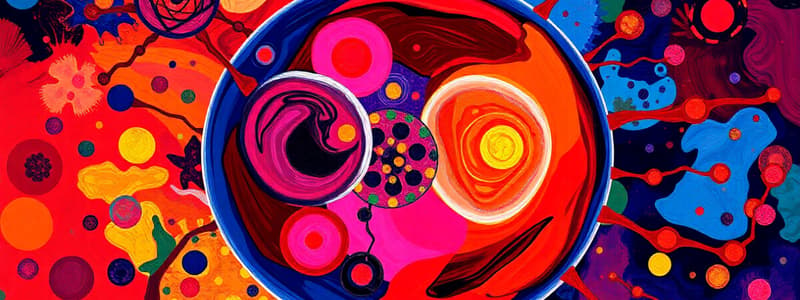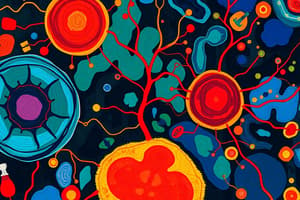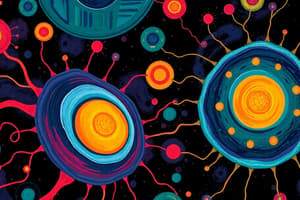Podcast
Questions and Answers
Which of the following is a form of local communication?
Which of the following is a form of local communication?
- Endocrine signaling
- Neurotransmitters
- Paracrine signaling (correct)
- Contact dependent signals (correct)
Long-distance communication includes gap junctions.
Long-distance communication includes gap junctions.
False (B)
What is the primary difference between lipophilic and lipophobic ligands in regards to their receptors?
What is the primary difference between lipophilic and lipophobic ligands in regards to their receptors?
Lipophilic ligands bind to intracellular receptors, while lipophobic ligands bind to cell surface receptors.
The binding of a neurotransmitter to a receptor in the synaptic cleft is an example of __________ communication.
The binding of a neurotransmitter to a receptor in the synaptic cleft is an example of __________ communication.
Which of the following hormones is responsible for regulating glucose levels in the blood?
Which of the following hormones is responsible for regulating glucose levels in the blood?
Match the receptor types with their associated functions:
Match the receptor types with their associated functions:
List the first step of a reflex control pathway.
List the first step of a reflex control pathway.
Neural reflexes are generally slower than endocrine reflexes.
Neural reflexes are generally slower than endocrine reflexes.
Flashcards
Gap Junctions
Gap Junctions
Direct cytoplasmic connections between adjacent cells allowing ions and small molecules to pass. This allows for rapid communication and coordination between cells, seen in tissues like cardiac muscle.
Contact-Dependent Signals
Contact-Dependent Signals
Signals requiring direct contact between cells through cell adhesion molecules (CAMs) on their surface. This allows for precise communication and regulation of cell behavior.
Paracrine Signaling
Paracrine Signaling
A cell releases a chemical signal affecting nearby cells. This allows for localized communication and control within a specific region.
Autocrine Signaling
Autocrine Signaling
Signup and view all the flashcards
Endocrine Signaling
Endocrine Signaling
Signup and view all the flashcards
Lipophilic Ligand
Lipophilic Ligand
Signup and view all the flashcards
Lipophobic Ligand
Lipophobic Ligand
Signup and view all the flashcards
Cell Surface Receptors
Cell Surface Receptors
Signup and view all the flashcards
Study Notes
Local Communication
- Three forms of local communication exist:
- Gap junctions: Direct cytoplasmic connections between adjacent cells, allowing ions and small molecules to pass. An example is cardiac muscle cells.
- Contact-dependent signals: Require cell-to-cell contact via cell adhesion molecules (CAMs).
- Diffusing chemicals:
- Paracrine signaling: Chemical signals released by a cell affect nearby cells (e.g., histamine during inflammation).
- Autocrine signaling: A cell releases a chemical signal that acts on itself (e.g., immune cells releasing interleukins).
Long-Distance Communication
-
Two forms of long-distance communication exist:
- Blood transport: Hormones released into the bloodstream act on distant targets (e.g., insulin regulating glucose levels).
- Neurochemicals:
- Neurotransmitters: Released by neurons into the synaptic cleft.
- Neuromodulators: Modulate other neurons.
- Neurohormones: Released by neurons into the blood for action at distant targets.
-
Nervous system: Electrical signals travel along neurons, often followed by neurotransmitter release at synapses (e.g., motor neuron activation of a muscle)..
Lipophilic Ligand Binding
- Ligands diffuse through the cell membrane.
- The ligand binds to an intracellular receptor inside the cell’s cytoplasm or nucleus, causing a conformational change.
- The receptor-ligand complex binds to specific DNA regions, affecting gene expression/protein synthesis.
- This process is slower compared to cell surface receptor activation.
Lipophobic Ligand Binding
- Ligand binds to a surface receptor.
- The receptor activates intracellular signaling pathways.
- Intracellular messengers (e.g., cAMP, Ca2+) amplify the signal.
- Cellular changes occur (e.g., enzyme activation, ion channel activity).
- This response occurs more rapidly than intracellular receptor activation.
Cell Surface Receptors
- Four major groups of cell surface receptors:
- Chemically-gated ion channels: Open/close in response to ligand binding, altering ion flow (e.g., nicotinic acetylcholine receptors).
- G protein-coupled receptors (GPCRs): Activate intracellular G proteins, leading to second messenger production (e.g., adrenergic receptors).
- Receptor-enzyme complexes: Contain enzyme activity or are linked to enzymes, influencing intracellular reactions (e.g., receptor tyrosine kinases like the insulin receptor)
Receptor Properties
- Specificity: Receptors bind to specific ligands based on shape and chemical compatibility.
- Competition: Different ligands can compete for the same receptor.
- Affinity: Strength of ligand-receptor binding. Stronger binding = higher affinity.
- Saturation: All receptors are occupied at high ligand concentrations, maximizing the response.
Reflex Pathway Steps
- Stimulus: Environmental change detected.
- Sensor: Receptor detects the stimulus.
- Input Signal: Signal travels to the integrating center via afferent pathways.
- Integrating Center: Processes input and determines a response.
- Output Signal: Response signal travels via efferent pathways.
- Target (Effector): Cell/organ carrying out the response.
- Response: Action taken to restore homeostasis.
Neural vs. Endocrine Reflexes
- Speed: Neural reflexes are very fast (milliseconds). Endocrine reflexes are slower (minutes to hours).
- Specificity: Neural reflexes are highly specific. Endocrine reflexes are more widespread (affect cells with relevant receptors).
- Signals: Neural use electrical and chemical signals. Endocrine uses chemical signals (hormones).
- Duration: Neural are short-lived. Endocrine are longer-lasting.
- Coding: Neural reflexes code stimulus intensity as the frequency of action potentials, endocrine reflexes as hormone concentration.
Studying That Suits You
Use AI to generate personalized quizzes and flashcards to suit your learning preferences.




